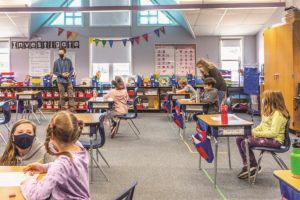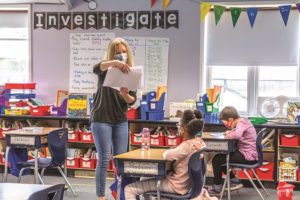TRURO — Truro Central School (TCS) head second-grade teacher Amelia Rose feels, she announces, as she hurries from teaching remote addition class in the library to delivering an in-person version of that same lesson in her classroom, where indoor, distanced recess just wrapped up and a ritual mask break is next, “totally normal — really.”
When Gov. Charlie Baker shuttered Massachusetts public schools on March 16, 2020, teachers scrambled to adjust to the virtual model forced on them. Making distance learning work for elementary school students was especially challenging. Those frantic spring months saw “a lot of maintenance and a lot of activities,” says Rose. “But there wasn’t a lot of learning.”

Come fall, the schools to-open-or-not-to-open dilemma dominated Facebook groups, headlines, and the presidential campaign. “There were more questions than answers,” says Rose. Could in-person learning be safe for students? For teachers? For parents? Would remote learning leave a generation lost? Could all the head-swiveling and screen-toggling required of hybrid learning really allow for meaningful, effective teaching? In essence: no matter its form, wasn’t children’s learning this year doomed to fail?
TCS hoped the answer was no. On Sept. 28, it became the only Outer Cape elementary school to open its doors to students seeking in-person instruction. Remote learning was an option, too, both for temporary spells or for the entire year. That means that each teacher spends each day switching between in-person, remote, and hybrid learning — “which definitely took some getting used to,” says Rose.
But six months have passed. TCS allowed this reporter to spend an ordinary Tuesday in Rose’s classroom earlier this month. The experience offered up none of the madness one might expect from, say, an attempt to teach one screenful and one roomful of masked eight-year-olds about pandas. If the day revealed any fundamental truth, it was this: these times are unprecedented no more. Rose wasn’t scrambling, or beside herself, or adjusting to some new foreign system. She was just teaching second grade.
Twelve of Rose’s students come to school every day, except in the case of quarantine or other temporary illness. They walk into their classroom, stash their coats and bags in cubbies, then head straight for the all-important hand-washing station, where, if their skin seems dry from all the scrubbing, Rose keeps moisturizer at the ready.

At 8:30 a.m., every student — sitting at his assigned, six-feet-apart desk — gets out his Chromebook and opens Seesaw, a kid-friendly classroom app on which the students access their daily schedules, join online meetings, and fill out all their worksheets. Gone this year are the days of stacks of papers for the teachers to bring home. Instead, teachers comb each night through the students’ digital portfolios.
The three second-graders studying completely remotely this year open their Seesaw at 8:30, too, for a hybrid all-class greeting. On this Tuesday, the students meet with TCS guidance counselor and school social worker Nancy Winslow for Second Step, a social-emotional-learning curriculum she teaches weekly.
And then begins the academic day. Rose isn’t alone in her classroom; to adjust to a stay-in-one-place model of learning, TCS has split its teachers into so-called cohorts. For the second grade, that’s a team of five: head teacher Rose; teacher assistant Andre Lima; Jennifer Spoor, a reading specialist; Alison Waldo, a Spanish teacher; and Joshua Paul, a gym teacher and student teacher. Those five are responsible for the second grade all day.
From 9 to 10:15 a.m., as Rose leads a literacy workshop from the front of her classroom, Lima walks around, checking in on students, and Spoor leads a remote version of Rose’s lesson, then a hybrid guided reading exercise from the library nook, the second grade’s assigned remote-learning spot.
When she is done, it’s back to the classroom, where Rose projects a picture book about Chinatown (the second grade is studying a different culture each week) onto the classroom’s smart-screen.
Before Covid, reading time would happen in a circle on the classroom rug. “I think that’s what I miss the most,” says Rose. But students can’t move from their desk bubbles during class. Their lessons change; they stay in place.
After read-aloud, poetry, activities on Seesaw, and more guided reading, the students have a snack, then take their excursion of the day: to the gym, to meet cohort member Joshua Paul. They skip and jump in distanced lines and play a lot of pass — a natural six-feet-apart game.
Then Rose leads an in-person, panda-description writing lesson. Coordinated by Spoor, the remote students follow along on their own time; they upload their sample sentences to Seesaw, where all the teachers can check their progress later that day.
As Lima supervises lunchtime, Rose and Spoor get their first mask breaks of the day, in first-grade teacher Nina Picariello’s classroom. They talk about one particular joy of teaching younger students this year: flexibility. “The kids are just great about it,” Spoor says, “because they just accept that this is what second grade is like.”
“Which” — she paused — “is a little sad, that this is their reality. But I guess it’s like that for all of us.”

After indoor recess and quiet time comes Rose’s math dash. Lima takes charge of the classroom; Rose practices addition with her remote students. Then she leaves them to do some independent Seesaw work, rushes back to her classroom, and starts the same lesson over again, in person.
“It’s the best way to do it,” she says. “Not everybody is where they might have been in a typical year, but that’s OK, because the learning is happening. Everyone is making all the gains they can at this point in time. It’s worked out so well.”
Between math and phonics, the last lesson of the day, the classroom takes its daily movement break: a follow-along dance set to Elton John’s “I’m Still Standing.” The students mainly do their own dances. The teaching cohort hits every choreographed move with perfect precision.
“It’s our favorite,” says Lima. “The second grade is the place to be.”



